
Giovanni Boccaccio was an Italian writer, poet, correspondent of Petrarch, and an important Renaissance humanist. Boccaccio wrote a number of notable works, including The Decameron and On Famous Women. He wrote his imaginative literature mostly in Tuscan vernacular, as well as other works in Latin, and is particularly noted for his realistic dialogue which differed from that of his contemporaries, medieval writers who usually followed formulaic models for character and plot.

The Doge's Palace is a palace built in Venetian Gothic style, and one of the main landmarks of the city of Venice in northern Italy. The palace was the residence of the Doge of Venice, the supreme authority of the former Venetian Republic. It was founded in 1340, and extended and modified in the following centuries. It became a museum in 1923, and is one of the 11 museums run by the Fondazione Musei Civici di Venezia.
Michael Panaretos was an official of the Trapezuntine empire and a Greek historian. His sole surviving work is a chronicle of the Trapezuntine empire of Alexios I Komnenos and his successors. This chronicle not only provides a chronological framework for this medieval empire, it also contains much valuable material on the early history of the Ottoman Turks from a Byzantine perspective, however it was almost unknown until Jakob Philipp Fallmerayer discovered it in the nineteenth century among the manuscripts of the Biblioteca Marciana of Venice. "Owing to this drab but truthful chronicle," writes the Russian Byzantist Alexander Alexandrovich Vasiliev, "it has become possible to a certain extent to restore the chronological sequence of the most important events in the history of Trebizond. This Chronicle covers the period from 1204 to 1426 and gives several names of emperors formerly unknown."

The Euganean Hills are a group of hills of volcanic origin that rise to heights of 300 to 600 m from the Padovan-Venetian plain a few km south of Padua. The Colli Euganei form the first Regional park established in the Veneto (1989), enclosing fifteen towns and eighty one hills.

The Museo Correr is a museum in Venice, northern Italy. Located in St. Mark's Square, Venice, it is one of the 11 civic museums run by the Fondazione Musei Civici di Venezia. The museum extends along the southside of the square on the upper floors of the Procuratorie Nuove. With its rich and varied collections, the Museo Correr covers both the art and history of Venice.

Giovanni Dondi dell'Orologio, also known as Giovanni de' Dondi, was an Italian physician, astronomer and mechanical engineer in Padua, now in Italy. He is remembered today as a pioneer in the art of clock design and construction. The Astrarium, which he designed and built over a period of 16 years, was a highly complex astronomical clock and planetarium, constructed only 60 or so years after the very first mechanical clocks had been built in Europe, and demonstrated an ambitious attempt to describe and model the planetary system with mathematical precision and technological sophistication.
Venetus A is the more common name for the tenth century AD manuscript catalogued in the Biblioteca Marciana in Venice as Codex Marcianus Graecus 454, now 822.
The Grimani family were a prominent Venetian patrician family, including three Doges of Venice. They were active in trade, politics and later the ownership of theatres and opera-houses. Notable members included:

The Carraresi (or da Carrara) were an important family of northern Italy in the 12th to 15th centuries. As signori of Padua, their overwhelming power and patronage placed them in an isolated position far outshining any other single family. Their extensive land holdings in the Paduan contado were supplemented by extensive property within the comune itself, and their political prominence made them comparable to the Scaligeri of contemporary Verona, or the Visconti of Milan. Margaret Plant has examined how "in its period of domination in Padua from 1337 to 1405 the house of Carrara sustained a singular chapter in the history of patronage". Francesco il Vecchio, son of Giacomo, a close friend of Petrarch in his early years, was a noted patron of Petrarch himself and commissioned frescoes (destroyed) illustrating Petrarch's De viris illustribus in the palazzo, c. 1367–1379, employing Guariento and others; Petrarch's retirement years were spent at Arquà, a Carrara fief, and he bequeathed to Francesco his picture of the Virgin by Giotto.

The Bianco World Map is a map created by Andrea Bianco, a 15th-century Venetian sailor and cartographer. This map was a part of a nautical atlas including ten pages made of vellum. These vellum pages were previously held in an 18th-century binding, but the current owner, Venetian library Biblioteca Marciana, separated the pages for individual exhibition.
Pier Alessandro Paravia was a Venetian writer, scholar, philanthropist and professor of Italian eloquence at the University of Turin.
Jacopo Dondi dell'Orologio (1290–1359), also known as Jacopo de' Dondi, was a doctor, astronomer and clock-maker active in Padua, Italy. He is remembered today as a pioneer in the art of clock design and construction. He was the father of Giovanni Dondi dell'Orologio. Jacopo Dondi wrote on a number of subjects, including surgery, pharmacology, astrology and natural science.

Venetian Renaissance architecture began rather later than in Florence, not really before the 1480s, and throughout the period mostly relied on architects imported from elsewhere in Italy. The city was very rich during the period, and prone to fires, so there was a large amount of building going on most of the time, and at least the facades of Venetian buildings were often particularly luxuriantly ornamented.
The Lamezia Terme Town Library is located in the historic centre of the former village of Nicastro and more precisely in the Nicotera-Severisio historical building located in the Tommaso Campanella square.





















